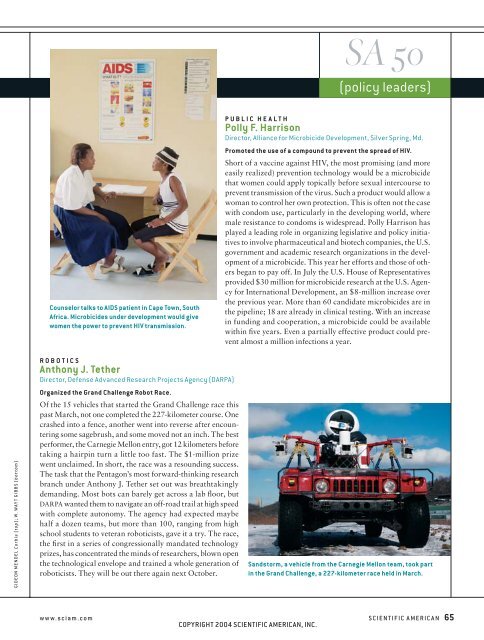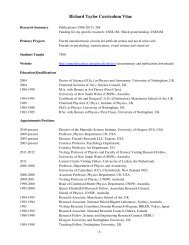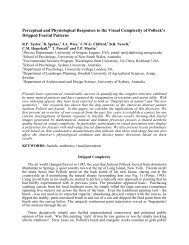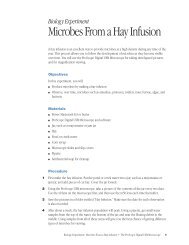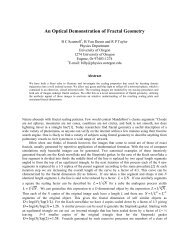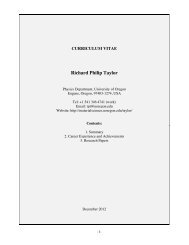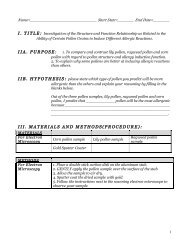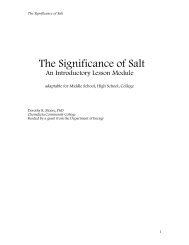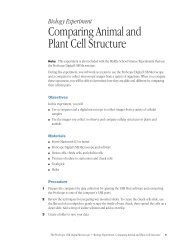December 2004 - Materials Science Institute - University of Oregon
December 2004 - Materials Science Institute - University of Oregon
December 2004 - Materials Science Institute - University of Oregon
Create successful ePaper yourself
Turn your PDF publications into a flip-book with our unique Google optimized e-Paper software.
GIDEON MENDEL Corbis ( top); W. WAYT GIBBS (bottom)<br />
Counselor talks to AIDS patient in Cape Town, South<br />
Africa. Microbicides under development would give<br />
women the power to prevent HIV transmission.<br />
ROBOTICS<br />
Anthony J. Tether<br />
Director, Defense Advanced Research Projects Agency (DARPA)<br />
Organized the Grand Challenge Robot Race.<br />
Of the 15 vehicles that started the Grand Challenge race this<br />
past March, not one completed the 227-kilometer course. One<br />
crashed into a fence, another went into reverse after encountering<br />
some sagebrush, and some moved not an inch. The best<br />
performer, the Carnegie Mellon entry, got 12 kilometers before<br />
taking a hairpin turn a little too fast. The $1-million prize<br />
went unclaimed. In short, the race was a resounding success.<br />
The task that the Pentagon’s most forward-thinking research<br />
branch under Anthony J. Tether set out was breathtakingly<br />
demanding. Most bots can barely get across a lab fl oor, but<br />
DARPA wanted them to navigate an <strong>of</strong>f-road trail at high speed<br />
with complete autonomy. The agency had expected maybe<br />
half a dozen teams, but more than 100, ranging from high<br />
school students to veteran roboticists, gave it a try. The race,<br />
the fi rst in a series <strong>of</strong> congressionally mandated technology<br />
prizes, has concentrated the minds <strong>of</strong> researchers, blown open<br />
the technological envelope and trained a whole generation <strong>of</strong><br />
roboticists. They will be out there again next October.<br />
SA 50<br />
(policy leaders)<br />
PUBLIC HEALTH<br />
Polly F. Harrison<br />
Director, Alliance for Microbicide Development, Silver Spring, Md.<br />
Promoted the use <strong>of</strong> a compound to prevent the spread <strong>of</strong> HIV.<br />
Short <strong>of</strong> a vaccine against HIV, the most promising (and more<br />
easily realized) prevention technology would be a microbicide<br />
that women could apply topically before sexual intercourse to<br />
prevent transmission <strong>of</strong> the virus. Such a product would allow a<br />
woman to control her own protection. This is <strong>of</strong>ten not the case<br />
with condom use, particularly in the developing world, where<br />
male resistance to condoms is widespread. Polly Harrison has<br />
played a leading role in organizing legislative and policy initiatives<br />
to involve pharmaceutical and biotech companies, the U.S.<br />
government and academic research organizations in the development<br />
<strong>of</strong> a microbicide. This year her efforts and those <strong>of</strong> others<br />
began to pay <strong>of</strong>f. In July the U.S. House <strong>of</strong> Representatives<br />
provided $30 million for microbicide research at the U.S. Agency<br />
for International Development, an $8-million increase over<br />
the previous year. More than 60 candidate microbicides are in<br />
the pipeline; 18 are already in clinical testing. With an increase<br />
in funding and cooperation, a microbicide could be available<br />
within fi ve years. Even a partially effective product could prevent<br />
almost a million infections a year.<br />
Sandstorm, a vehicle from the Carnegie Mellon team, took part<br />
in the Grand Challenge, a 227-kilometer race held in March.<br />
www.sciam.com SCIENTIFIC AMERICAN 65<br />
COPYRIGHT <strong>2004</strong> SCIENTIFIC AMERICAN, INC.


